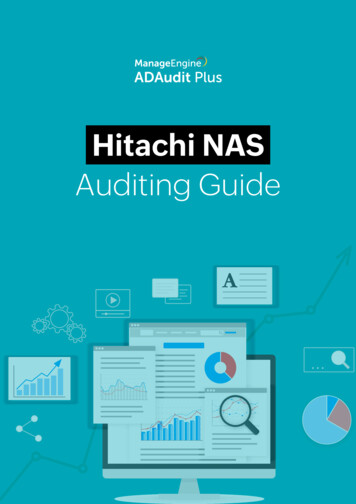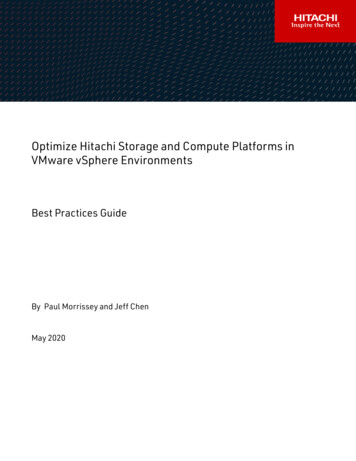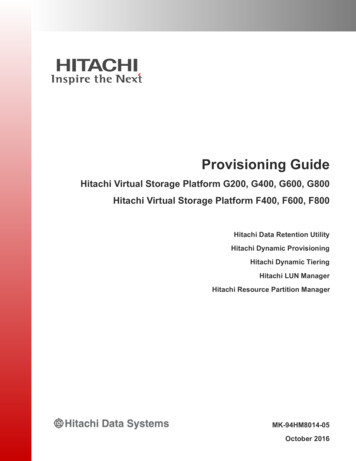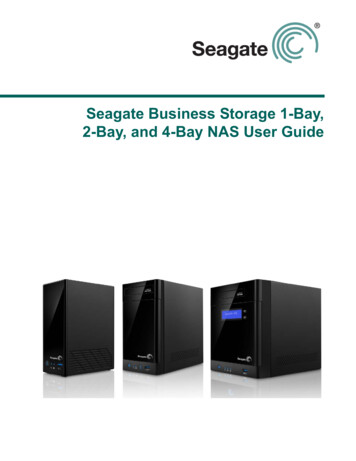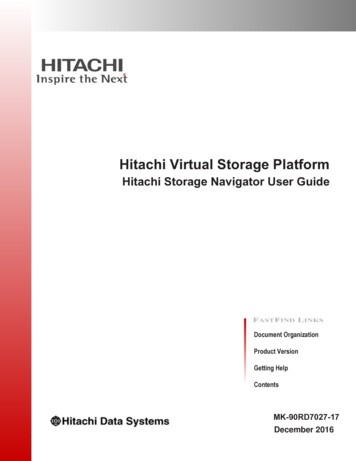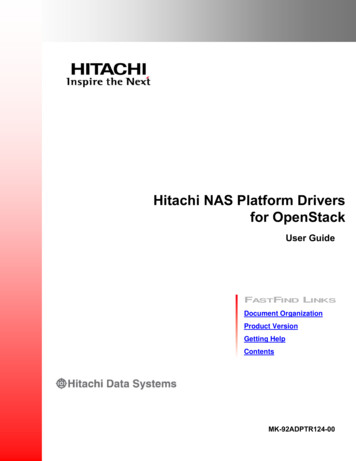
Transcription
Hitachi NAS Platform Driversfor OpenStackUser GuideFASTFIND LINKSDocument OrganizationProduct VersionGetting HelpContentsMK-92ADPTR124-00
2016 Hitachi, Ltd. All rights reserved.No part of this publication may be reproduced or transmitted in any form or by any means, electronic ormechanical, including photocopying and recording, or stored in a database or retrieval system for any purposewithout the express written permission of Hitachi, Ltd.Hitachi, Ltd., reserves the right to make changes to this document at any time without notice and assumes noresponsibility for its use. This document contains the most current information available at the time ofpublication. When new or revised information becomes available, this entire document will be updated anddistributed to all registered users.Some of the features described in this document might not be currently available. Refer to the most recentproduct announcement for information about feature and product availability, or contact Hitachi Data SystemsCorporation at https://portal.hds.com.Notice: Hitachi, Ltd., products and services can be ordered only under the terms and conditions of theapplicable Hitachi Data Systems Corporation agreements. The use of Hitachi, Ltd., products is governed by theterms of your agreements with Hitachi Data Systems Corporation.Hitachi is a registered trademark of Hitachi, Ltd., in the United States and other countries. Hitachi DataSystems is a registered trademark and service mark of Hitachi, Ltd., in the United States and other countries.Archivas, Essential NAS Platform, HiCommand, Hi-Track, ShadowImage, Tagmaserve, Tagmasoft,Tagmasolve, Tagmastore, TrueCopy, Universal Star Network, and Universal Storage Platform are registeredtrademarks of Hitachi Data Systems.AIX, AS/400, DB2, Domino, DS6000, DS8000, Enterprise Storage Server, ESCON, FICON, FlashCopy, IBM,Lotus, MVS, OS/390, RS/6000, S/390, System z9, System z10, Tivoli, VM/ESA, z/OS, z9, z10, zSeries, z/VM,and z/VSE are registered trademarks or trademarks of International Business Machines Corporation.
ContentsContents . 2About this guide . 4Who should use this guide . 4Related information and publications . 4Getting help. 5Comments . 5Chapter 1. Introduction . 6Driver Architecture . 7General considerations . 8Package nomenclature . 9Hitachi NAS Platform (HNAS) requirements . 9OS and platform support .10Compatibility and requirements .10Driver restrictions and limitations. 11Cinder supported features . 11Chapter 2. Installation . 12Install Packages .12Uninstalling the OpenStack Cinder HNAS Driver: .13Chapter 3. Configuration . 14Service labels .18Multi-backend configuration .18Managing volumes .19SSH configuration .20Configuration example .22Chapter 4. Troubleshooting . 26Resolving patching errors .26Hnasgetinfo tool.26Common errors and resolutions .27Chapter 5. Best practices . 28Use NFS protocol .28Chapter 6. Known issues . 28Hitachi NAS Platform Drivers for OpenStack User Guide2
Chapter 7. General questions . 29Is there any specification where metadata, such as ldev and copy method, is kept in volume andsnapshot?.29Does the HNAS driver support OpenStack functions (live migration, multipath, FC zoning manager, HAenvironment)? .30If HNAS driver supports live migration, what settings do I need to use? .30In HA cluster configuration, what settings do I need to use for the HNAS driver? .30Does the HNAS driver support NAS OS12.6 (or later)?.30What is the server prerequisite information, such as memory, HDD, and capacity? .30What is the specification of log generation management? .30Hitachi NAS Platform Drivers for OpenStack User Guide3
About this guideThis document contains the installation and user guide of the Hitachi NAS Platform (HNAS)Drivers for OpenStack. Although some Cinder operations are mentioned in this guide, describingOpenStack operations is out of the scope of this document.Who should use this guideThis guide is intended for anyone who installs, configures, and performs Cinder operations. Thisdocument assumes that they have basic knowledge of Linux operating system.Related information and publicationsOpenStack documentation OpenStack Cloud Administrator Guide OpenStack Command-Line interface Reference OpenStack Configuration Reference Red Hat Enterprise Linux OpenStack Platform Product Manual SUSE OpenStack Cloud Product ManualHitachi NAS Platform and Virtual Storage Platform Gx00 documentation Hitachi NAS Platform 3080 and 3090 G1 Hardware Reference Hitachi NAS Platform 3080 and 3090 G2 Hardware Reference Hitachi NAS Platform Series 4000 Hardware Reference Hitachi NAS Platform System Manager Unit (SMU) Hardware Reference Hitachi NAS Platform and Hitachi Virtual Storage Platform Gx00 Virtual SMU Administration Guide Hitachi NAS Platform and Hitachi Unified Storage System Installation Guide Hitachi NAS Platform and Hitachi Virtual Storage Platform Gx00 System Access Guide Hitachi NAS Platform and Hitachi Virtual Storage Platform Gx00 File Service Administration Guide Hitachi NAS Platform and Hitachi Virtual Storage Platform Gx00 Server Cluster and Administration Guide Hitachi NAS Platform and Hitachi Virtual Storage Platform Gx00 Storage Subsystem Administration GuideHitachi NAS Platform Drivers for OpenStack User Guide4
Hitachi NAS Platform and Hitachi Virtual Storage Platform Gx00 Backup AdministrationGuide Hitachi NAS Platform and Hitachi Virtual Storage Platform Gx00 User AdministrationGuide Hitachi NAS Platform and Hitachi Virtual Storage Platform Gx00 Network AdministrationGuide Hitachi NAS Platform and Hitachi Virtual Storage Platform Gx00 Antivirus AdministrationGuideGetting helpThe Hitachi Data Systems Support Connect is the destination for technical support of productsand solutions sold by Hitachi Data Systems. To contact technical support, log on to Hitachi DataSystems Support Connect for contact information: https://support.hds.com/en us/contactus.html.Hitachi Data Systems Community is a global online community for HDS customers, partners,independent software vendors, employees, and prospects. It is the destination to get answers,discover insights, and make connections. Join the conversation today! Go tohttps://community.hds.com, register, and complete your profile.CommentsPlease send us your comments on this document: doc.comments@hds.com. Include the document title, number, and revision, and refer to specific section(s) and paragraph(s) wheneverpossible.Thank you! (All comments become the property of Hitachi Data Systems Corporation.)Hitachi NAS Platform Drivers for OpenStack User Guide5
Chapter 1. IntroductionIn OpenStack Block Storage (Cinder), the driver layer is the one that makes the communicationbetween the commands the end user sends by the UI (Horizon) or CLI and the storage used asbackend. The driver receives the commands from Cinder volume manager, sends the propercommands to the storage, returning the results to Cinder.Figure 1 below shows an example of how the Hitachi NAS Platform (HNAS) drivers work in theoverall OpenStack environment:Figure 1 Overview of an OpenStack environment with HNASHitachi NAS Platform Drivers for OpenStack User Guide6
Driver ArchitectureVolume ManagerNFS Driver LayeriSCSI Driver LayerHNAS Backend LayerFigure 2 Concept diagram of the driver architectureThe Volume Manager is responsible for sending the commands to the specific driver. Eachconfigured backend is an instance of the Volume Manager and calls the driver’s specificbehavior.The NFS Driver Layer provides support to work with the Network File System protocol by usingHNAS as a NFS server and the controllers, computes and storage nodes as clients. This layermounts the NFS export configured on HNAS in those Cinder nodes and uses multiple Linux andHNAS backend commands to handle the Cinder volumes. Similarly, the iSCSI Driver Layerprovides support to work with the iSCSI (internet Small Computer Interface) protocol byconnecting iSCSI initiators in the controller, computes and storage nodes to iSCSI targetsconfigured on HNAS file systems. The driver handles the operations by using the HNAS backendcommands in the backend, including the creation and deletion of targets when needed.The HNAS Backend Layer is responsible for executing commands in HNAS, parsing andformatting the output, and reporting back to the drivers (NFS or iSCSI), which actually containall the logic. SSC handles the complexity of the protocol used to communicate with HNAS; it isby default installed in the HNAS system and is used via SSH by the HNAS Backend part of thedriver.The HNAS Driver (NFS or iSCSI) supports up to 4 different storage pools, such as file systemswhen using iSCSI or exports when using NFS, per backend. Each file system or export can beconfigured in HNAS to provide different levels of Quality of Service. These pools are selected bythe Cinder scheduler according to the volume type associated with the volume being created.Hitachi NAS Platform Drivers for OpenStack User Guide7
Figure 3 Communication diagram for HNAS driverGeneral considerationsStarting with the driver version 1.5.0, you can no longer run the driver using a locally installedinstance of the SSC utility package. Instead, all communications with the HNAS backend arehandled through SSH. This version also deprecates the xml configuration file in favor of havingthe entire driver configuration in the cinder.conf file.Hitachi NAS Platform Drivers for OpenStack User Guide8
Package nomenclatureThe initial version of the driver released to the community had adopted the following versionnaming convention X.Y.Z, where X shows new features, Y, bug fixes, and Z, non-functionalchanges. The community version sequence is 1.0 for Juno, 3.0 for Kilo (version 2.0 was anintermediate version between Juno and Kilo), and 4.0 for Liberty.The version numbering convention used for Hitachi enterprise drivers is different from that ofthe community drivers, and it is X.Y.Z-W-YYYY.R, where: X is the driver major version number;Y is the driver minor version number;Z id the bug fix version number;W is the package build number;YYYY.R is the OpenStack release with which this driver is compatible (e.g.: 2015.1 is thekilo release and 2015.2 is the liberty release);The current enterprise version is v1.5.0-0-2015.2.Hitachi NAS Platform (HNAS) requirementsThe HNAS driver v1.5.0 provides support for HNAS models 3080, 3090, 4040, 4060, 4080 and4100 with NAS OS 12.2 or higher.Before using iSCSI and NFS services, use the HNAS configuration and management GUI (SMU) orSSC CLI to configure HNAS to work with the drivers.1. General requirements:a. It's mandatory to have at least 1 storage pool, 1 EVS and 1 file system to be ableto run any of the HNAS drivers.b. HNAS drivers consider the space allocated to the file systems to provide thereports to Cinder. So, when creating a file system, make sure it has enough spaceto fit your needs.c. The file system used should not be created as a replication target and should bemounted.Hitachi NAS Platform Drivers for OpenStack User Guide9
d. It's possible to configure HNAS drivers to use distinct EVSs and file systems, butall compute nodes and controllers in the cloud must have access to the EVSs.2. For NFS:a. Create NFS exports, choose a path for them (it must be different from "/") andset the Show snapshots option to hide and disable access.b. For each export used, set the option norootsquash in the share "Accessconfiguration" so Cinder services can change the permissions of its volumes. Forexample, "* (rw, norootsquash)".c. Make sure that all computes and controllers have R/W access to the shares usedby Cinder HNAS driver.d. In order to use the hardware accelerated features of NFS HNAS, we recommendsetting max-nfs-version to 3. Refer to HNAS command line reference to seehow to configure this option.3. For iSCSI:a. You must set an iSCSI domain to EVS.OS and platform supportThe HNAS driver version 1.5.0 is supported for Red Hat Enterprise Linux OpenStack Platform,SUSE OpenStack Cloud and Ubuntu OpenStack in the versions compatible with the OpenStackLiberty release. Note that these systems bring a community version of HNAS drivers that are notofficially supported. To use the enterprise version of the drivers, you must follow theinstructions described in Chapter 2. Installation and Chapter 3. Configuration.Compatibility and requirementsThe following packages must be installed in all compute and controllers/storage nodes: nfs-utils for Red Hat Enterprise Linux OpenStack nfs-client for SUSE OpenStack CloudHitachi NAS Platform Drivers for OpenStack User Guide10
nfs-common, libc6-i386 and cinder-common for Ubuntu OpenStackThe following packages must be installed in all controllers/storage nodes: cinder-volume for Red Hat Enterprise Linux OpenStack, SUSE OpenStack Cloudand Ubuntu OpenStack Cloud.Driver restrictions and limitations The driver does not manage a volume if the volume name has a slash ('/') or acolon (‘:’) , SSC simultaneous connections limit: In very busy environments, if 2 or morevolume hosts are configured to use the same storage, some requests, such ascreate or delete, can have some attempts failed and retried (5 attempts bydefault) due to an HNAS connection limitation (max of 5 simultaneousconnections). Each backend can have up to 4 services (pools). File system auto-expansion: Although supported, Hitachi Data Systems does notrecommend using file systems with auto-expansion setting enabled because thescheduler uses the file system capacity reported by the driver to determine ifnew volumes can be created. For instance, in a setup with a file system that canexpand to 200GB but is at 100GB capacity, with 10GB free, the scheduler will notallow a 15GB volume to be created. In this case, manual expansion would have tobe triggered by an administrator. Hitachi Data Systems recommends alwayscreating the file system at the maximum capacity or periodically expanding thefile system manually. iSCSI driver limitations: The iSCSI driver has a limit of 1024 volumes attached toinstances. The hnas svcX volume type option must be unique for a given backend.Cinder supported featuresFollowing are the Cinder operations supported by the HNAS driver:Hitachi NAS Platform Drivers for OpenStack User Guide11
Create VolumeDelete VolumeAttach VolumeDetach VolumeExtend VolumeCreate SnapshotDelete SnapshotList SnapshotCreate Volume from SnapshotCreate Volume from ImageCreate Volume from Volume (Clone)Create Image from VolumeManage VolumeUnmanage VolumeVolume Migrate (host assisted)Image CachingBackup attached volumesQoSVolume ReplicationConsistency SupportedNot SupportedNot SupportedNot SupportedChapter 2. InstallationInstall PackagesThe HNAS drivers are distributed in rpm or deb packages. In order to install the drivers, simplydownload the latest version compatible with your supported Operating System fromhttps://support.hds.com and install it through your OS official package manager.Installation instructions for Ubuntu (deb)Open a Linux terminal and execute the following command: sudo dpkg -i hnas 1.5.0-0-2015.2 all.debInstallation instructions for Red Hat / Suse (rpm)Open a Linux terminal and execute the following command: sudo rpm -ivh hnas-1.5.0 0 2015.2-1.el7.noarch.rpmHitachi NAS Platform Drivers for OpenStack User Guide12
Or you can use another tool to automatically resolve dependencies problems if any: sudo yum --nogpgcheck localinstall hnas-1.5.0 0 2015.2-1.el7.noarch.rpmNOTE: The OpenStack Cinder HNAS Drivers should be installed in every Cinder node ofyour OpenStack deployment.Uninstalling the OpenStack Cinder HNAS Driver:In order to uninstall the OpenStack Cinder HNAS Drivers, simply use your package manager toremove the HNAS package from your system. This process will not remove your configurationsfrom /etc/cinder/cinder.conf.Uninstall instructions for Ubuntu (deb)Open a Linux terminal and execute the following command: sudo dpkg -r hnasUninstall instructions for Red Hat / SUSE (rpm)Open a Linux terminal and execute the following command: sudo rpm -e hnas-1.5.0 0 2015.2-1.el7.noarchHitachi NAS Platform Drivers for OpenStack User Guide13
Chapter 3. ConfigurationHNAS supports a variety of storage options and file system capabilities, which are selectedthrough the definition of volume types combined with the use of multiple backends and/ormultiple services. Each backend can configure up to 4 service pools, which can be mapped toCinder volume types.The configuration for the driver is read from the backend sections of the cinder.conf. Eachbackend section must have the appropriate configurations to communicate with your HNASbackend, such as the IP address of the HNAS EVS that is hosting your data, HNAS SSH accesscredentials, the configuration of each of the services in that backend, etc. You can find examplesof such configurations in Configuration example.NOTE 1: The new HNAS drivers still support the XML configuration the same way it was in theolder versions, but it is recommended that you configure the new HNAS drivers only throughthe cinder.conf file, since the XML configuration file from previous versions is beingdeprecated as of version 1.5.NOTE 2: It's not recommended to use the same NFS export or file system (iSCSI driver) fordifferent backends. If possible, configure each backend to use a different NFS export or filesystem.Hitachi NAS Platform Drivers for OpenStack User Guide14
The table below provides the definition of each configuration option that can be used in a HNAS backend section in thecinder.conf file:OptionTypeDefaultDescriptionvolume backend nameOptionalNot applicablevolume driverRequiredNot applicablenfs shares configRequired (only for NFS)/etc/cinder/nfs shares Path to the nfs shares file. This is required by the base Cinder genericNFS river and therefore also required by the HNAS NFS driver.The python module path to the HNAS volume driver python class. Wheninstalling through the rpm or deb packages, you should configure this tocinder.volume.drivers.hitachi.hnas.hnas iscsi.HNASISCSIDriver for theiSCSI backend orcinder.volume.drivers.hitachi.hnas.hnas nfs.HNASNFSDriver for the NFSbackend.This file should list, one per line, every NFS share being used by thebackend, i.e., all the values found in the configuration keyshnas svcX hdp in the HNAS NFS backend sections.E.g. For a backend configuration:[hnas-nfs] hnas svc0 hdp 172.24.44.112:/export1hnas svc1 hdp 172.24.44.113:/export2The nfs shares config file should have the following t2hnas mgmt ip0RequiredNot applicableHNAS management IP address. Should be the IP address of the "Admin"EVS. It is also the IP through which you access the web SMUadministration frontend of HNAS.hnas chap enabledOptional (iSCSI only)TrueBoolean tag used to enable CHAP authentication protocol for iSCSIHitachi NAS Platform Drivers for OpenStack User Guide15
driver.hnas usernameRequiredNot applicablehds hnas nfs config fileandhds hnas iscsi config fileOptional (deprecated)/opt/hds/hnas/cinder Path to the deprecated XML configuration file (only required if using the[nfs iscsi] conf.xmlXML file)hnas cluster admin ip0Optional (required only for Not applicableHNAS multi-farm setups)The IP of the HNAS farm admin.If your SMU controls more than one system or cluster, this option mustbe set with the IP of the desired node. Note that this is different forHNAS multi-cluster setups, which does not require this option to be set.hnas ssh private keyOptionalNot applicablePath to the SSH private key used to authenticate to the HNAS SMU. Onlyrequired if you don’t want to set hnas password.hnas ssh portOptional22Port on which HNAS is listening for SSH connectionshnas passwordRequired (unlesshnas ssh private key isprovided)Not applicableHNAS passwordRequired (at least 1)Not applicableHDP (export or file system) where the volumes will be created. Useexports paths for the NFS backend or the file system names for the iSCSIbackend (note that when using the file system name, it does not containthe IP addresses of the HDP). Examples:hnas svcX hdp1HNAS ssh usernameNFS: hnas svc0 hdp 172.24.44.112:/export1ISCSI: hnas svc0 hdp FS-cinderhnas svcX iscsi ip1Required (only for iSCSI)Not applicableThe IP of the EVS that contains the file system specified inhnas svcX hdp.hnas svcX volume type ErrorRequired! Bookmark not defined.Not applicableA unique string that is used to refer to this pool within the context ofCinder. You can tell Cinder to put volumes of a specific volume type intothis backend, within this pool. See, Service labels and Configurationexample for more details.hnas enable traceFalseWhen set to True, enables the trace behavior of HNAS Drivers. It will log11OptionalReplace X with a number from 0 to 3 (keep the sequence when configuring the driver).Hitachi NAS Platform Drivers for OpenStack User Guide16
the driver functions calls, arguments and return values on/var/log/hnas/debug.log file.This option should be added in the [DEFAULT] section of cinder.conf.Hitachi NAS Platform Drivers for OpenStack User Guide17
Service labelsHNAS driver supports different types of service using the service labels. It is possible to createup to 4 types of them for each backend, for example, gold, platinum, silver, and ssd.After creating the services in the cinder.conf configuration file, you need to configure oneCinder volume type per service. Each volume type must have the metadataservice label with the same name configured in the hnas svcX volume type option ofthat service. See Configuration example for more details. If the volume type is not set,Cinderservice pool with largest available free space or other criteria configured in schedulerfilters.Multi-backend configurationYou can deploy multiple OpenStack HNAS driver instances (backends) that each controls aseparate HNAS or a single HNAS. If you use multiple Cinder backends, remember that eachCinder backend can host up to 4 services. Each backend section must have the appropriateconfigurations to communicate with your HNAS backend, such as the IP address of the HNASEVS that is hosting your data, HNAS SSH access credentials, the configuration of each of theservices in that backend, etc. You can find examples of such configurations in Configurationexample.If you want the volumes from a volume type to be casted into a specific backend, you mustconfigure an extra spec in the volume type with the value of the volume backend nameoption from that backend.For multiple NFS backends configuration, each backend should have a separatednfs shares config and, if using different shares for them, separated nfs shares filedefined (e.g. nfs shares1, nfs shares2) with the desired shares listed in separated lines.See the example below:cinder.conf[backend-1]nfs shares config /home/cinder/nfs shares1Nfs shares filesPath of the file - /home/cinder/nfs shares1Content - 172.24.44.112:/export1Hitachi NAS Platform Drivers for OpenStack User Guide18
172.24.44.112:/export2[backend-2]nfs shares config /home/cinder/nfs shares2Path of the file - /home/cinder/nfs shares2Content - ng volumesIf there are some existing volumes on HNAS that you want to import to Cinder, it's possible touse the manage volume feature to do this. The manage action on an existing volume is verysimilar to a volume creation. It creates a volume entry on Cinder database, but instead ofcreating a new volume in the backend, it only adds a 'link' to an existing volume. Note that it'san admin-only feature and you have to be logged as an user with admin rights to be able to usethis. For NFS:1. Under the tab Admin - Volumes choose the option [ Manage Volume ]2. Fill the fields Identifier, Host and Volume Type with volume information to bemanaged:Identifier: ip:/type/volume name (e.g. 172.24.44.34:/silver/volume-test)Host: host@backend-name#pool name (e.g. ubuntu@hnas-nfs#test silver)Volume Name: volume name (e.g. volume-test)Volume Type: choose the type of volume (e.g. silver)By CLI: cinder manage --name volume-test --volume-type silver st silver For iSCSI:1. Under the tab Admin - Volumes choose the option [ Manage Volume ]2. Fill the fields Identifier, Host and Volume Type with volume information to bemanaged:Identifier: filesystem-name/volume-name (e.g. filesystem-test/volume-test)Host: host@backend-name#pool name (e.g. ubuntu@hnas-iscsi#test silver)Volume Name: volume name (e.g. volume-test)Volume Type: choose the type of volume (e.g. silver)By CLI:Hitachi NAS Platform Drivers for OpenStack User Guide19
cinder manage --name volume-test --volume-type silver filesystem-test/volume-testubuntu@hnas-iscsi#test silverSSH configurationYou can use username and password to authenticate the Cinder storage node to the HNASbackend. In order to do that, simply configure hnas username and hnas password in yourbackend section within the cinder.conf file as shown below:[hnas-iscsi] hnas username supervisorhnas password supervisor[hnas-nfs] hnas username supervisorhnas password supervisorAlternatively, the HNAS driver also supports SSH authentication through public key. To configureSSH authentication through public key:1. If you don't have a pair of public keys already generated, create it in the Cinderstorage node (leave the pass-phrase empty): mkdir -p /opt/hitachi/ssh ssh-keygen -f /opt/hds/ssh/hnaskey2. Change the owner of the key to cinder (or the user the volume service will be runas):# chown -R cinder.cinder /opt/hitachi/ssh3. Create the directory "ssh keys" in the SMU server: ssh [manager supervisor]@ smu-ip 'mkdir -p /var/opt/mercurymain/home/[manager supervisor]/ssh keys/'Hitachi NAS Platform Drivers for OpenStack User Guide20
4. Copy the public key to the "ssh keys" directory: scp /opt/hitachi/ssh/hnaskey.pub [manager supervisor]@ smuip :/var/opt/mercury-main/home/
The HNAS driver version 1.5.0 is supported for Red Hat Enterprise Linux OpenStack Platform, SUSE OpenStack Cloud and Ubuntu OpenStack in the versions compatible with the OpenStack Liberty release. Note that these systems bring a community version of HNAS drivers that are not
